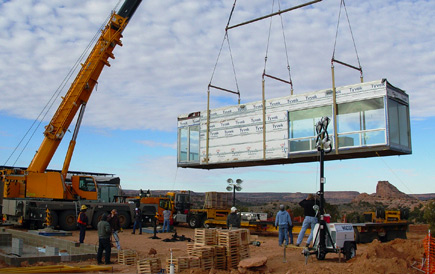Frustrated Inhabitat reader Bob Ellenberg wrote to the site commenting on the "green" qualities of many prefab homes; they decided to post his critique. The essay sparked posts on a number of other blogs, as well as numerous comments to the original post. Some of Bob's original points:
"I don't want to pick on prefab construction, as I do quite a bit of it myself as a design/builder and there are certainly many aspects of it that can be 'green.' But some of the claims I see being made relative to overall sustainability of prefab houses are overstated and might even be considered 'Green-Washing'."Specifically, he cited three areas where prefab homes might not exactly be 'green':
"Over-Engineering - Factory produced modular homes often require more material than site-built homes, and this is definitely not green....With a factory built house, you have to lift a large module, load it on a truck, haul it down the road and set it with a crane. Because all of these operations concentrate the load on specific points instead of it being spread as it is over a foundation or a slab, the support system must be considerably overbuilt.
"Carbon Cost of Shipping - Shipping modular homes definitely adds to the carbon footprint as well. Truck loads of materials go to local suppliers, travel short distances to site built homes and stay there. Truck loads of materials go to factories, are built into houses and then travel hundreds of miles on oversized trucks....Then the crane which gets about 2-3 mpg travels to the job site to set the house and unless you are in a major city they could end up coming a long way."
"Studies in the Canadian construction industry have shown that as much as 30% of materials are wasted through theft, water damage, or offcuts being tossed in the dumpster. In a prefab factory, nothing is stolen, nothing is thrown out, even the sawdust is used for heating."Chuck added:
"Having acted as my own contractor to have a timber frame, enclosed with structural insulated panels, house built, it occurs to me that the factory could be brought to the jobsite with a modification of this method of construction. Perhaps we need to borrow the best method form factory and on-the-job techniques, instead of thinking either-or."User andrew k compared prefab building techniques to site-built in Arizona:
"Hailing from a city that is completely focused on production housing (Phoenix) I can say that prefab must be very,very bad before it can compare with the sprawl of today's suburbia. Most of the skilled labor in the Phoenix area drive substantial distances to the jobsites, and while there, create substantial dust problems. Even in a subdivision where there are two homes in similar stages of construction directly next to each other, material waste is fairly staggering, it's common to see each structure with its own dumpster. Combine material theft into the mix, and the whole process is very, very unsustainable."
Philip Proefrock added his thoughts on the matter at Green Options:
"In and of itself, pre-fab is not automatically "green." When done well, it can be a method that leads to a better constructed home, including one that uses fewer materials and operates more efficiently (meaning less carbon footprint over the building's lifetime, a much larger chunk of its carbon footprint to consider than its construction). In green building, we try to take a look at the larger picture, rather than only focusing on the final building alone. Life cycle issues, and the methods and processes all contribute to making a building green. It's the execution of the concept, and not the idea itself, that makes or breaks a prefab as a greener building."
And, Lloyd Alter of Treehugger posted his two cents:
"Like any building, prefab is as green as its builders want it to be....Prefab holds the promise of delivering a greener home in less time and perhaps even less money, but it is only as green as the designer and the builder."

